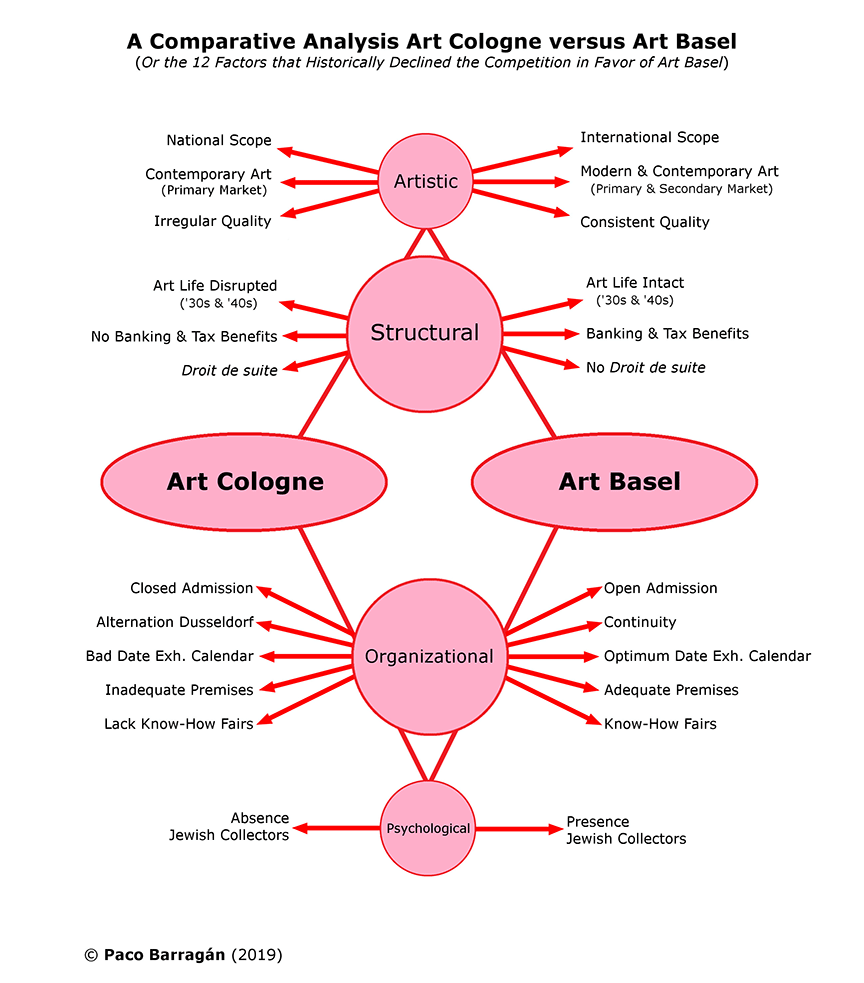« Features
PUSH TO FLUSH. ART COLOGNE versus Art Basel: The 12 Factors that Have Historically Tilted the Competition in Favor of Art Basel
By Paco Barragán
Like Charles Dickens’ famous novel A Tale of Two Cities, the history of the contemporary art fair of the 1970s and 1980s can be explained by the extraordinary rivalry between Cologne and Basel. I will try to formulate here why ART COLOGNE, though being the first contemporary art fair, lost that primacy to Art Basel. It’s indeed a fascinating story whose ingredients need to be recapitulated point by point.
The convoluted story of ART COLOGNE has basically to do with bad luck, but also with the concatenation of one disaster after the other. In fact, ART COLOGNE is exactly that: one bad decision after the other from its very inception in 1967 until the tide changed with the hiring of Daniel Hug in 2008. And it’s even more surprising because ART COLOGNE had every ingredient to be successful: a strong private and public collecting infrastructure in the Rhineland and the full support of the city of Cologne and its cultural department.
So let’s untangle plainly the intricacies of this competition that has largely defined the future of art fairs. Accordingly, we can break down the Cologne-Basel comparison by looking at a series of categories that are structural, psychological, organizational and artistic in nature.
The first relevant element is the Swiss banking system and its tax advantages, which were a competitive asset in the eyes of foreign galleries compared to Cologne, as are Miami and Hong Kong. Also, and no less important, was the absence of the Folgerecht (resale right) in Switzerland that existed in Germany. Third, a factor that cannot be understated is the fact that, after the Nazis took power in the 1930s, Cologne, like the rest of Germany and France, had lost its artistic infrastructures and international connections. Practically, Cologne was 20 years behind Switzerland, where the institutions and market had remained intact. Finally, the tragedy perpetrated by the Nazis meant that nearly all Jewish art dealers and collectors fled the country. This brought with it an important psychological frame of mind: Jewish collectors, as Ernst Beyeler once admitted, no longer wanted to go to Germany and preferred, at least at the time, to buy in Switzerland.
From an organizational point of view, the Cologne fair was organized exclusively by the Verein progressiver deutscher Kunsthändler (Association of Progressive German Art Dealers). This was one of the major blunders that would herald its demise, as the selection process was undemocratic and rather unprogressive, allowing practically only the members of the VPDK to participate. Astoundingly, not even other galleries from other parts of Germany were accepted. The result was that, as dissatisfaction with the selection process grew, fairs in Dusseldorf, Frankfurt, Berlin and even others in Cologne emerged and the market became fragmented. In 1970, there was even a famous performance titled We Will Enter the Kunstmarkt staged by Joseph Beuys and Wolf Vostell, among others, that literally demanded an opening up of the art fair by smashing hard objects on the closed doors. Then, from 1975 to1983, the fair was held alternately in Cologne and Dusseldorf, a change that was obviously a bad decision that would contribute to the fair’s instability. VPKD members also lacked the technical and organizational skills that the Schweizer Mustermesse under Emil Bammatter had developed. In addition, the original fair venues at the Kunsthalle Köln and Kölnischer Kunstverein were too small, and one of the biggest mistakes was the date of the art fair: November. This simply meant that the powerful American galleries and collectors stayed away.
Finally, we should examine the artistic aspect and scope of the fair. At ART COLOGNE, the selection process favored galleries in Cologne and other regional locations that were members of the VPDK. This sent the message that, on one hand, it was a very regional fair in comparison to the internationally oriented Art Basel and, on the other, its selections were of much lower quality. This small thinking made the fair look provincial and weak, while Art Basel championed an international scope and quality-driven selection process. Yet another aspect was that, from the very beginning, ART COLOGNE was too focused on contemporary art-it was the launch platform of Pop art in Europe-while Art Basel aimed at the primary and secondary markets at the same time: classical modernism, post-war modernism and contemporary art. And this formula would hit the jackpot.
Ultimately, ART COLOGNE’s’ historical disruption of its art structures, its imposition of the Folgerecht, the loss of Jewish collectors, the less favorable tax situation, its undemocratic selection process that favored membership before quality, the venue sharing with Dusseldorf, the lack of a suitable space and organizational and technical experience in setting up art fairs, the inappropriate date, its regional bias, the irregular quality of its featured works and its excessive focus on contemporary art are, in my opinion, the 12 elements that explain why “the first art fair,” as ART COLOGNE likes to call itself, hasn’t ended up being the first art fair after all.
Paco Barragán is a PhD candidate at the University of Salamanca (USAL) in Spain and the former visual arts curator of Centro Cultural Matucana 100 in Santiago, Chile. He recently curated “Juan Dávila: Painting and Ambiguity” (MUSAC, 2018), “Arturo Duclos: Utopia´s Ghost” (MAVI, 2017) and “Militant Nostalgia” (Toronto, 2016). He is the author of The Art to Come (Subastas Siglo XXI, 2002) and The Art Fair Age (CHARTA, 2008).




































Leave a Reply
You must be logged in to post a comment.